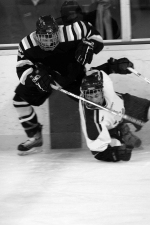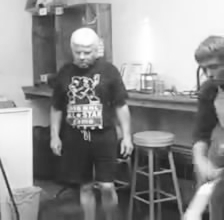We coaches -- in almost all sports -- might be considered a rather odd lot. We study and study our game, and we analyze and maybe even over-analyze just about every aspect of play. And trust me, that I'm no exception. ;) Back home in Massachusetts, I was (lovingly, I'm sure) referred to by many hockey parents as "The Nutty Professor". Ya, I've been known to come up with some of the wildest drills anyone has ever seen.
Still, I'd never change the approach I've taken in my work. Even a study as outside the box as the following one has proven hugely beneficial -- to my players and to me.
-- Dennis Chighisola
What We Can Learn from Hockey Penalties
I'm guessing it was sometime in the early 1980's when the subject of this post first crossed my mind. I know it was during one of my first seasons as a college head coach, and I can even remember the two players who caused me to think there was a connection between penalties and some other playing difficulties. Actually, both guys were pretty good players. However, one was returning from an injury, while I suspected the other didn't have the kind of stamina I expected. Of course, upperclassmen that they were, and good players that they were, you might imagine that they put up quite a stink when I suggested their playing time might be reduced for an upcoming game. I do recall, however, that I gave both guys a chance once the next game started. The one returning from the injury didn't last too long into the game before he had to call it a night. On the other hand, the guy I suspected of being out of shape at least tried to take a regular shift.
Okay, so the Nutty Professor tends to come out in me when I do something mindless, like driving home from a game -- rehashing and rehashing things in my mind, and trying to make sense of some things that many others might not even consider.
The morning after, I contacted one our team's volunteer stats people, and asked if she could go through all of our games to that point in the season, and provide me with the types of penalties taken by each of our players. On the drive home the previous night, I couldn't help but think about the penalties both of the guys in question had taken. It wasn't that they took a lot -- it was probably a combined total of three, but it was the nature of those penalties that had gotten me into Nutty Professor mode.
Now, think along with me, if you will... I already knew what penalties the suspected out of shape kid had taken in that recent game. However, since his conditioning had seemingly been off for the entire early season, it was his whole body of work that I was really interested in seeing. In other words, if we were 7- or 8-games into our schedule, I had a feeling that all the penalties he'd amassed up through the last game would be similar, and they'd tell a certain story.
 Bingo! Beside that young guy's name was listed calls like hooking, tripping and holding, and he probably had at least two of each. Among knowledgeable hockey coaches, a hooking penalty is frequently seen as a sign of laziness. In other words, instead of hustling and skating his buns off, the player gives less effort than necessary, he coasts, and then just reaches for an opposing puckcarrier with the stick. In my player's case, however, while being out of shape can make one lazy, I believe he was running out of gas and just not able to catch his man. And I quickly saw the other penalties in the same light... My guy reached out often with his stick to take some tripping penalties; and he also lost tussles along the boards, these resulting in holding calls.
Not stopping there, and with the entire roster in front of me, I scanned down to see if I could spot any other unusual groupings of penalties.
Sure enough, another of my players spent time in the box for calls similar to the first guy. I didn't see him being out of shape, however, although I could easily understand why his rather large body and slowness of foot caused him to take a number of hooking and holding penalties. And so was there another young guy who wasn't exactly known for his footwork listed as taking a batch of similar penalties.
Bingo! Beside that young guy's name was listed calls like hooking, tripping and holding, and he probably had at least two of each. Among knowledgeable hockey coaches, a hooking penalty is frequently seen as a sign of laziness. In other words, instead of hustling and skating his buns off, the player gives less effort than necessary, he coasts, and then just reaches for an opposing puckcarrier with the stick. In my player's case, however, while being out of shape can make one lazy, I believe he was running out of gas and just not able to catch his man. And I quickly saw the other penalties in the same light... My guy reached out often with his stick to take some tripping penalties; and he also lost tussles along the boards, these resulting in holding calls.
Not stopping there, and with the entire roster in front of me, I scanned down to see if I could spot any other unusual groupings of penalties.
Sure enough, another of my players spent time in the box for calls similar to the first guy. I didn't see him being out of shape, however, although I could easily understand why his rather large body and slowness of foot caused him to take a number of hooking and holding penalties. And so was there another young guy who wasn't exactly known for his footwork listed as taking a batch of similar penalties.
Ye Old Professor wasn't done there, either. For, with some time to kill, and a couple of pages of stats at my disposal, I scanned down through the rest of our roster to see if I could connect those with other player tendencies.
Oh, could I ever... For example, here are the types of penalties our resident (self proclaimed) goon amassed: roughing, charging, cross-checking, boarding, slashing... Need I say more?
As interesting as all the rest, though, was our second most penalized player, who had totaled only a few less minutes than the team's supposed tough guy. His penalties seemed to be all over the board, with calls like charging, hooking, cross-checking and tripping.
Okay, so you could be wondering what the big deal is here, and how it could be that there is something to be learned from studying a player's penalties. Well...
- First, I think it's important that coaches, parents, players and the media keep statistics in a certain perspective. Professional teams and agents for the pros might like to beat each other over the heads with stats at contract time, but I'm just using whatever I can gather to suggest to me some tendencies, or even some maybes.
- Over the 20-plus years since I first conducted that (very unscientific) study, I've found that the types of penalties players get do give me some insight into what's happening with a given player. At times, I've even been able to use that as evidence in the event I want a guy to make some changes to his game or to his preparations for the game.
- I've discovered that there can be several reasons why a player gets called for certain kinds of penalties. Again, the types of penalties he takes are only helpful in suggesting he has a problem. It's up to the player and me to figure what that problem might be.
- In other words, I have to know the player -- or watch him more closely -- to decide whether penalties like hooking, holding and tripping mean he is injured, out of shape, or maybe just lacking the speed or skills to keep up with quicker or more agile opponents.
- In much the same way, the guy taking all the roughhouse kind of penalties may either be playing selfishly and being overly aggressive, or he might be the type who is trying to hustle and dig but just has subpar body-checking skills or technique.


No comments:
Post a Comment